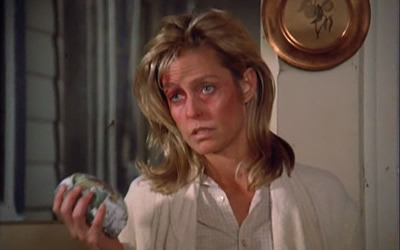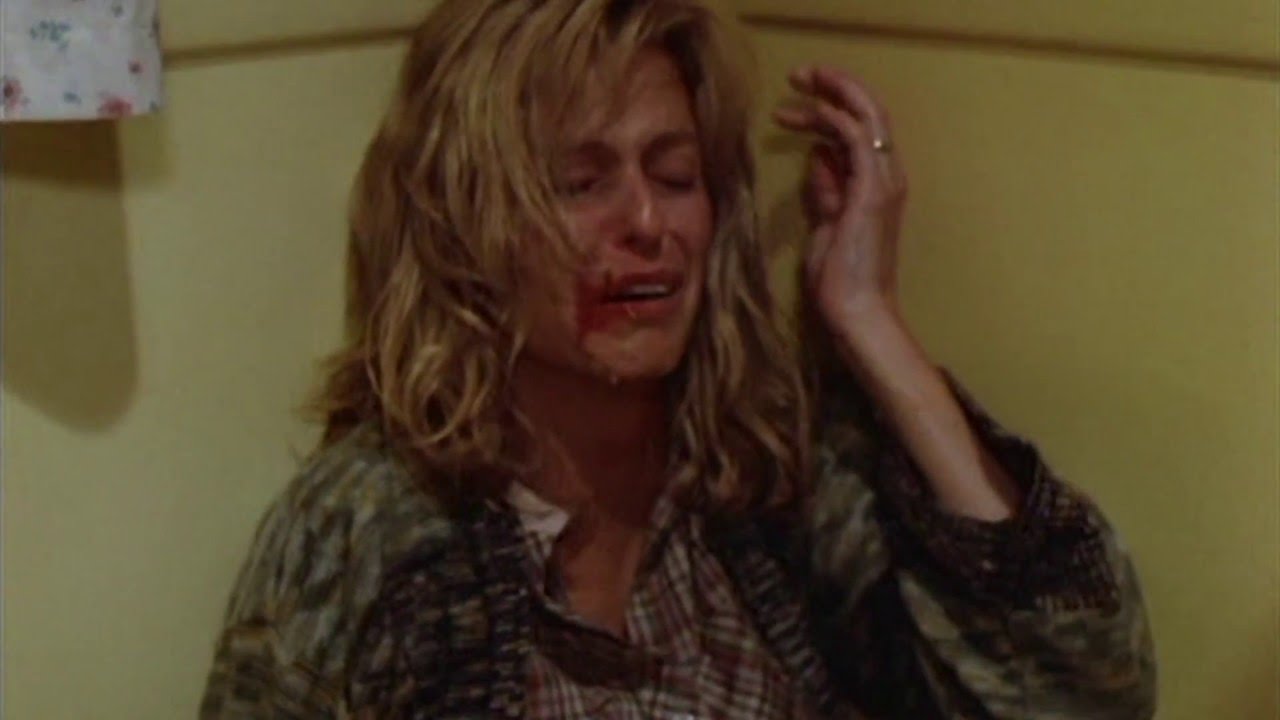Director: Robert Greenwald
Starring: Farrah Fawcett, Paul Le Mat, Richard Masur
Year: 1984
When your only claim to fame is Xanadu, you know your career didn’t work out exactly the way you planned it. At least Olivia Newton-John has Grease to fall back on, although her lack of literally any other movie to hang her hat on is shocking, especially considering how big a deal she was. Obviously people quickly understood that she could sing, but she most definitely could not act. I’ve actually seen what is basically Greenwald’s only other film of note other than a ton of documentaries that no one has seen; Breaking Up, a 1997 drama starring an up-and-coming Russell Crowe and Salma Hayek. But that’s neither here nor there, and The Burning Bed is neither musical nor romance. It’s a made-for-TV, true life horror story that brought the subject of abuse to American living rooms in a way that can’t be remembered without being applauded.
The Movie
Francine’s family were mountain people, which means they didn’t have much but they didn’t need much, that they valued hard work and personal pride above all things. As Francine grew, she understood that she was beautiful, but she didn’t want to settle for simply being some handsome man’s wife. She wanted to go to school, maybe get a job, maybe move to a bigger town, perhaps become someone important in a world that was opening up for women and revealing new opportunities every day. But some people hold tight to the old beliefs that men are in charge, that they marry who they please, and that wives do what their husbands tell them to do. Francine found herself in this type of relationship, through bad choices and bad luck, and it wasn’t easy to get out.
Mickey was a determined man, and when he set his sights on Francine he knew that he would talk her into marrying him. Francine wanted to wait, to see the world first, but no one had ever made such a fuss over her, told her she was attractive, told her they loved her, that they couldn’t live without her. So Mickey and Francine were married, despite not having jobs or a place to live. Soon, Mickey’s evil temperament would make itself obvious, and he would beat Francine whenever she displeased him. At first, she convinced herself she was to blame, later she would leave him, but by that time they had children together, and the well-being of her children was Francine’s top concern. When she realized that she would never be able to get away from Mickey completely, she did something desperate, something terrible, but perhaps something necessary as well.
This film does open the conversation on abuse up in a way that only a strong story can, because sometimes we need to see it with our own eyes to believe it, as stupid as that sounds, and as ridiculous as it is that a simple film could be what it takes to get an important message across. And this is a true story don’t forget, a real case of “battered-woman syndrome” in which the abusive situation the murderer was in came into play during their court case. Because you can debate the ethics of the verdict, but the fact is that someone was killed here, and that victim was constantly trying to destroy the live of another victim. Judge for yourself what the punishment should be, but this story forces us to give spousal abuse a face, and to think about the extremity of the mental damage inflicted as well.
It was a pretty big deal for sex symbol Farrah Fawcett to try a heavy drama like this, to put her acting talent on display when most people thought she was just a pretty face. Logan’s Run, Sunburn, Saturn 3, Cannonball Run; she was just a blonde beauty, but this film opened the doors and Farrah pushed through. Now, to be honest, her film career never really panned out, but she did do a lot of made-for-TV, true-life stuff in the late 80s, which became kind of her thing. She’s not bad at all in The Burning Bed, a movie that could not have been very comfortable to create, and something that I see as very important, so I applaud her attempt. Paul Le Mat plays a very convincing Mickey, and the entire film holds the 70s feel it was going for extremely well. Is it the movie of the decade, of course not, but it has its historical value and its message, which isn’t nothing.
The Blu-ray
Video – With an aspect ratio of 1.33:1/1.78:1 (1920x1080p) and shot using Panaflex cameras and lenses by Panavision, the video quality of the Blu-ray disc is as poor as can be expected, but understandably so. There is an option in the main menu of wide or full screen, but neither are tremendously appealing, as the clarity of the picture quality isn’t something you should expect to dazzle, and may even have been hurt by the transfer.
Audio – The Blu-ray was done in English, with subtitles in English available to turn on or off. The audio quality of the disc is the same as the video; bad but not unexpected. There is some sense that that the music was selected with purpose, but that’s about it.
Extras – The only special features are an interview with director Robert Greenwald and five trailer for other films.
Final Thoughts
Recommended. This might be Farrah Fawcett’s most notable role, and perhaps her strongest as well. She tells an impacting story, never makes it about her as an actress, always keeps the message clear. She isn’t aided by much around her except for one good co-star, so give credit where credit is due. The film as a whole isn’t something extraordinary and won’t be remembered for its artistry. But it shares with us something meaningful, and I’m appreciative of that. The video is pretty bad, the audio the same, and there aren’t many extras, so look elsewhere for stellar technical attributes. If you’ve never seen this film before, it’s worth your time, just don’t expect too much.
☆ ☆ ☆ – Content
☆ ☆ – Video
☆ ☆ – Audio
☆ ☆ – Extras
☆ ☆ – Replay




